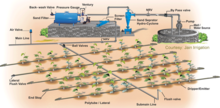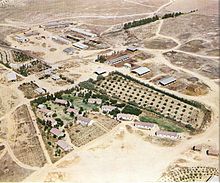Drip irrigation
The drip irrigation is an irrigation system , on to the tubes are mounted at regular intervals outlets on only small, precise quantities of water (l / h dropwise usually 2-4) largely independent of the pressure in the pipeline will be given. This process was first developed in dry countries to save water. It can also be used in protected horticultural cultivation under glass or under foil in Central Europe , but also in home gardens and parks. Drip irrigation is increasingly being used in viticulture , for example in the Wachau .
Other irrigation technologies such as the drum sprinkler can only irrigate small areas intensively and then change their position semi-automatically.
technology

Originally, the main hoses were connected with thin side hoses. Should a lot of water come out of the side hoses, these were shortened, which reduced the frictional resistance of the pipe. In the meantime, an emitter part with an integrated labyrinth limits the amount of water that can be discharged; the side hose is usually only used to water individual pots.
The irrigation drip is run at low pressures (about 0.1 to 4 bar ). In the slope area, care must be taken that not all of the water in the lower area escapes from the drip system. To avoid this, there are now also pressure-compensating drip systems that compensate for the pressure difference caused by the slope of the terrain. In high-quality drip systems, membranes are integrated, which only open at a certain pressure and thus prevent the drip pipe from running empty at the lowest point.
In modern horticulture, the use of drip irrigation is automated (see also watering automation ) using additional technology such as sensors, solenoid valves and corresponding control devices that regulate the time and amount of watering.
Drip irrigation can also be combined with deficit irrigation strategies .
Since with micro-irrigation hoses are laid in the cultivation area and a dripper is installed on each plant, this means that this system in open-air operation mostly only applies to individual plant crops and, because of the high workload, mainly on permanent crops such as vines and olives - or fruit growing is used. However, a positive aspect is reduced weed growth, since the water is primarily only available to the cultivated plants.
Above ground
A drip irrigation system is basically divided into the three areas of control unit, drip line and dripper. It can be controlled manually or automatically using a tensiometer in the crop. With above-ground drip irrigation, the drip lines are on the ground surface. The drippers can be very different, the long-path channel or attachable drippers are often used.
Underground
With this drip irrigation, the drip lines are laid below ground level. The installation is more complex as a result and a change in the position of the lines cannot be implemented as easily if necessary.
advantages
An obvious advantage is the saving of water through the exact application of the water while avoiding evaporation losses. The method is particularly advantageous in soils with little thickness and low water storage capacity, since otherwise the plants will soon be under water stress with a negative effect on their development.
Saving water usually also means saving costs. Drip irrigation is more expensive to purchase than other systems, but this is quickly compensated for by the saving of water. Sometimes an economical cultivation is only possible with drip irrigation or Fogponics (a branch of hydroponics ).
The process also offers the possibility of adding nutrients directly to the water. Another advantage is that the leaves are not wetted and therefore fungal diseases of the plants are not further promoted. Especially in developing and emerging countries, with poor infrastructure and low water pressure in the water supply systems, it can be used for drip irrigation.
Possible problems
That hoses and drippers is a disadvantage, especially in the fertigation , so the addition of fertilizers, can clog. This can be partially prevented by upstream filters.
In arid and semi-arid areas, drip irrigation can lead to a certain degree of salinisation of the soil; however, because of the great effectiveness of drip irrigation, relatively small amounts of water can be used to minimize salinization.
development
The principle of drip irrigation has been known since ancient times. Buried clay pots were filled with water so that it gradually penetrated the ground. For example, the Chinese watered their fields with it over 2000 years ago. The underground installation saved water and increased yield.
The engineer Simcha Blass developed this type of irrigation further. He had previously made an observation in the 1930s in Kibbutz Chazerim in the Negev desert: one tree grew faster than all the others in the immediate vicinity. Next to this it was dripping from a leaking water pipe. Inspired by this, he began to water the roots in a targeted and timed manner instead of simply submerging them completely under water as in the usual watering process. Twenty years later, Simcha introduced the first system of drip irrigation. It initially consisted of a simple plastic tube with lots of small holes in it. In his mostly rain-poor homeland, Israel, drip irrigation became common practice - for both commercial and private use. Even in the north of the country, with its heavy rainfall, thin hoses often supply garden plants with moisture.
Netafim, which was co-founded by the inventor Blass, became the world's top-selling producer of artificial irrigation systems. Developing countries in particular use this technology to achieve sufficient yields despite poor soils and scarce other water resources. Over 130 countries are already using drip irrigation technology. Netafim is one of over 160 technology companies in the Israeli water sector, whose work focuses on water efficiency, computerized irrigation systems, wastewater utilization and seawater desalination. More than fifty percent of the technology used worldwide for drip irrigation now comes from there. In 1976 the Netafim company laid a major milestone in the history of micro-irrigation with the first pressure-equalizing dripper.
But even more than forty years after the original system, which was adopted by the Israeli water engineer Blass from Poland, was further developed, the technology of drip irrigation is still being described by experts as being in its infancy. Only five percent of farmers worldwide use it as most of them rely on traditional flood irrigation, where water floods the fields. It works in areas where there is a lot of rainfall or water supplies. However, this is not the case in the numerous peripheral regions of the Third World and during periods of drought.
literature
- Irrigation in horticulture . Board of Trustees for Technology and Construction in Agriculture (KTBL); KTBL-Schrift 128, Münster 1988, ISBN 3-7843-1771-5 , p. 102
- Closed cultivation methods - growing of ornamental plants . Geisenheim Research Institute, field of ornamental plant cultivation; Taspo Practice No. 18, Braunschweig 1990, ISBN 3-87815-030-X
Individual evidence
- ↑ Harmen Storck: Taschenbuch des Gartenbaues , Stuttgart 1983, ISBN 3-8001-4112-4 , pp. 302-303
- ^ A b Anne Grudzinski: Semiararbeit Wasserwirtschaft. (PDF) Irrigation Coordination Office, accessed on September 30, 2018 .
- ↑ a b Tobias von Lossow: Blue Wonder . Ed .: German Society for Foreign Policy eV Country portrait July 2 - October 2016, June 30, 2016 ( dgap.org [accessed September 30, 2018]).
- ↑ Susanne Sporrer: The drip catcher . In: ZEIT ONLINE . No. May 20 , 2007 ( zeit.de [accessed September 30, 2018]).
- ^ Tomatoes and technology made in Israel. Institute of the German Economy, January 18, 2018, accessed on September 30, 2018 .
- ↑ Bernd Schröder: Israel: Agriculture in a dry climate. In: Telepolis. June 11, 2018, accessed September 30, 2018 .
- ↑ Michael Gneuss: Focus on high tech . In: THE WORLD . November 18, 2007 ( welt.de [accessed September 30, 2018]).
- ↑ Israel's pioneer of drip irrigation feeds nearly 1 billion people . In: Audiatur-Online . May 12, 2015 ( audiatur-online.ch [accessed September 30, 2018]).




